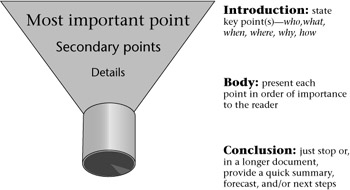Information
|
When people present facts that other people need to do their jobs, they're writing to inform. The goal of informative writing is to be concise and accurate. The focus should be on transferring the information quickly and easily. The communication fails if the reader doesn't understand the facts or, worse yet, misunderstands them.
The best way to communicate informatively is to use the pattern taught in journalism classes: the funnel. (See Figure 4-2.) Start with the fact or set of facts that is most important to the reader. In journalism, that's often who, what, when, where, why, and how? Then go to the next most important fact. Then the third level of importance. The fourth, the fifth, and so on, until there is nothing left to say. By structuring your document this way, you allow your readers to stop reading as soon as they have seen enough.

Figure 4-2: The Funnel-Shaped Structure of Informative Writing.
The challenge in writing informatively is to figure out which fact is most important to the reader. The most common mistakes are writing chronologically, which usually leads to wordiness, or starting with facts that matter to the writer but not to the reader, which usually leads to confusion or false emphasis.
Now wait a minute, you might be thinking. In the previous chapter we talked about decision heuristics and putting the kind of stuff up front that matters the most to the decision maker. Isn't that the same as the informative pattern? It's similar, and none of the structural patterns we'll be looking at can afford to start with content that the reader doesn't care about. But remember that the goal of persuasion is to motivate the decision maker to take action. Simply listing facts in a descending order of priority doesn't create any momentum toward action.
|
EAN: 2147483647
Pages: 130
- Measuring and Managing E-Business Initiatives Through the Balanced Scorecard
- A View on Knowledge Management: Utilizing a Balanced Scorecard Methodology for Analyzing Knowledge Metrics
- Measuring ROI in E-Commerce Applications: Analysis to Action
- Managing IT Functions
- Governance in IT Outsourcing Partnerships